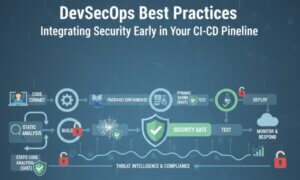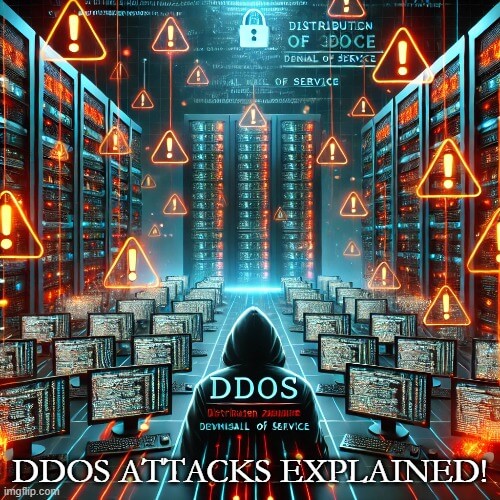A Distributed Denial-of-Service (DDoS) attack is a cyber threat designed to overwhelm a targeted server, network, or service with excessive traffic, rendering it inaccessible to legitimate users. DDoS attacks have become more prevalent and sophisticated, affecting businesses, government institutions, and even individuals. This blog will explore how DDoS attacks work, their impact, and the best strategies for defending against them.
What is a DDoS Attack?
A DDoS attack occurs when an attacker floods a target system with an overwhelming amount of traffic, usually generated by a network of compromised computers, known as a botnet. Unlike traditional Denial-of-Service (DoS) attacks, which originate from a single source, DDoS attacks leverage multiple sources, making them more difficult to mitigate.
How Do DDoS Attacks Work?

DDoS attacks follow a structured process that includes:
Botnet Formation: Cybercriminals infect multiple devices (computers, IoT devices, servers) with malware, converting them into botnets under their control.
Target Selection: The attacker chooses a target, which could be a website, cloud service, or network infrastructure.
Attack Execution: The botnet is instructed to send massive amounts of traffic to the target, overwhelming its resources and making it inaccessible to legitimate users.
Sustained Disruption: The attack continues until the target collapses under the load or deploys mitigation measures.
Types of DDoS Attacks

DDoS attacks can be categorized into three main types:
1. Volume-Based Attacks
These attacks flood a network with excessive traffic, consuming bandwidth and slowing down or disabling services.
Examples: UDP floods, ICMP floods, and DNS amplification attacks.
2. Protocol-Based Attacks
These attacks exploit vulnerabilities in network protocols to exhaust server resources.
Examples: SYN floods, Ping of Death, and Smurf attacks.
3. Application Layer Attacks
These attacks target specific applications or services, overloading them with seemingly legitimate requests.
Examples: HTTP floods, Slowloris attacks, and DNS query floods.
Consequences of DDoS Attacks
DDoS attacks can have severe consequences, including:
Financial Losses: Downtime caused by DDoS attacks can result in lost revenue, especially for e-commerce and financial services.
Reputational Damage: Repeated attacks can erode customer trust and damage brand reputation.
Operational Disruptions: Businesses may experience interruptions in daily operations, affecting employee productivity and service delivery.
Legal and Compliance Risks: Some industries must comply with cybersecurity regulations, and failing to prevent DDoS attacks may lead to penalties.
How to Defend Against DDoS Attacks
Organizations and individuals can take proactive measures to mitigate DDoS risks. Below are key strategies:
1. Implement Traffic Filtering and Rate Limiting
Use firewalls, intrusion prevention systems (IPS), and Web Application Firewalls (WAFs) to filter malicious traffic.
Set rate limits on incoming requests to prevent overwhelming traffic spikes.
2. Use DDoS Protection Services
Cloud-based DDoS protection services, such as Cloudflare, Akamai, and AWS Shield, can absorb and filter malicious traffic before it reaches the target.
These services offer real-time monitoring and automated mitigation strategies.
3. Deploy Network Redundancy and Load Balancing
Distribute network resources across multiple data centers or cloud servers to prevent single points of failure.
Use load balancers to evenly distribute traffic across different servers.
4. Monitor Traffic and Detect Anomalies
Implement Security Information and Event Management (SIEM) systems to analyze network traffic and detect abnormal patterns.
Set up alerts for sudden spikes in traffic to enable rapid response.
5. Strengthen Infrastructure with Anycast Technology
Anycast routing directs incoming traffic to multiple servers, reducing the impact of DDoS attacks.
This approach ensures that no single server bears the full burden of the attack.
6. Develop an Incident Response Plan
Establish a clear DDoS mitigation plan that includes roles, responsibilities, and escalation procedures.
Regularly conduct DDoS attack simulations to test preparedness.
7. Educate Employees and Users
Train employees to recognize and report suspicious network activity.
Encourage users to adopt security best practices, such as using VPNs and strong authentication measures.
Conclusion
DDoS attacks are a growing threat in today’s digital world, capable of causing significant financial and operational damage. By understanding how these attacks work and implementing robust defense mechanisms, individuals and organizations can minimize risks and maintain uninterrupted online services. Investing in proactive security measures and staying informed about emerging threats will help ensure long-term protection against DDoS attacks.
Why Businesses Trust SecureMyOrg for Comprehensive Network Security
At SecureMyOrg, we uncover and fix all possible security vulnerabilities of mobile and web, while providing solutions to mitigate risks. We are trusted by renowned companies like Yahoo, Gojek and Rippling, and with 100% client satisfaction, you’re in safe hands!







Some of the things people reach out to us for –
- Building their cybersecurity program from scratch – setting up cloud security using cost-effective tools, SIEM for alert monitoring, building policies for the company
- Vulnerability Assessment and Penetration Testing ( VAPT ) – We have certified professionals, with certifications like OSCP, CREST – CPSA & CRT, CKA and CKS
- DevSecOps consulting
- Red Teaming activity
- Regular security audits, before product release
- Full time security engineers.
Relevant Posts

How To Inspect Encrypted Traffic Without Breaking Privacy
Network administrators face a challenge: securing systems while respecting privacy. This guide explains how to inspect encrypted traffic without breaking privacy using metadata, anomaly detection, and machine learning ensuring visibility, compliance, and trust.

How to Audit Infrastructure as Code (IaC) for Security Vulnerabilities
Discover how to audit Infrastructure as Code (IaC) for security vulnerabilities with this practical guide. Learn to scan IaC files using tools like Checkov, fix issues like exposed resources, and integrate audits into CI/CD pipelines. Protect your cloud systems from misconfigurations and ensure compliance with clear, actionable steps.

DevSecOps Best Practices: Integrating Security Early in Your CI/CD Pipeline
This article provides a practical guide to embedding security into every stage of your CI/CD pipeline. Learn core DevSecOps best practices like SAST, DAST, dependency scanning, secrets management, and compliance automation to catch vulnerabilities early, foster a culture of shared ownership, and build a secure-by-design development process that accelerates release cycles.

5 Cloud Misconfigurations That Lead to Data Breaches
Cloud misconfigurations are one of the leading causes of data breaches, yet they’re also among the most preventable. From exposed storage buckets to weak IAM policies, attackers exploit these mistakes daily. Learn about the top 5 misconfigurations and how your organization can fix them before they lead to costly data exposure.

How Can Ethical Hacking Training Elevate Your Internal Cybersecurity?
Ethical hacking training empowers organizations to strengthen internal cybersecurity by uncovering vulnerabilities before attackers do. From mastering penetration testing to enhancing incident response, this training builds a proactive security culture. Learn how Secure My ORG’s programs can elevate your team’s skills and fortify defenses against modern threats like AI-driven attacks.

AI‑Generated Malware: Threat or Hype?
AI-generated malware uses advanced algorithms to create adaptive and hard-to-detect threats, posing serious challenges for modern cybersecurity defenses. Unlike traditional malware, it can evolve on its own, learning how to bypass security systems without human input. As a result, cybersecurity teams must increasingly rely on AI-driven tools and strategies to detect and neutralize these sophisticated digital attacks.
